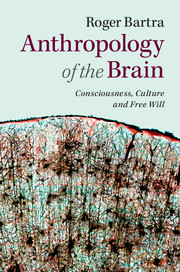Book contents
- Frontmatter
- Contents
- Preface
- Part I Consciousness and symbolic systems
- 1 The hypothesis
- 2 Evolution of the brain
- 3 Brain plasticity
- 4 Is there an internal language?
- 5 Amputations and supputations
- 6 The atrophied exocerebrum
- 7 The symbolic substitution system
- 8 Neuronal mirrors
- 9 Consciousness within hand’s reach
- 10 Outside and inside: the immense blue
- 11 The musical spheres of consciousness
- 12 Artificial memory
- 13 The lost soul
- Part II Brain and free will
- Bibliography
- Index
- References
11 - The musical spheres of consciousness
Published online by Cambridge University Press: 05 June 2014
- Frontmatter
- Contents
- Preface
- Part I Consciousness and symbolic systems
- 1 The hypothesis
- 2 Evolution of the brain
- 3 Brain plasticity
- 4 Is there an internal language?
- 5 Amputations and supputations
- 6 The atrophied exocerebrum
- 7 The symbolic substitution system
- 8 Neuronal mirrors
- 9 Consciousness within hand’s reach
- 10 Outside and inside: the immense blue
- 11 The musical spheres of consciousness
- 12 Artificial memory
- 13 The lost soul
- Part II Brain and free will
- Bibliography
- Index
- References
Summary
As we have seen, one of the greatest difficulties in understanding the relation between neuronal circuits and cultural networks is the rather rigid nature of linguistic codes, of the semantic system of meanings, and of syntactic structures. It is not easy to find neuronal correlates that reflect the peculiarities of speech. But if we jump to another cultural ambit, where symbols are very flexible and meanings lack a conventional fixation, perhaps we can obtain a different and illuminating approximation to the question of self-consciousness. I am referring to musical expressions that I have previously mentioned with regard to the theories of Susanne Langer. Just citing the concept, musical “expressions,” puts us in front of a complex situation. I will refer principally to the so-called classical instrumental music that is not accompanied by words. For centuries it has been said that music, composers, and performers “express” different emotions, passions, moods, and frames of mind. Of course this idea presupposes that music is able to, in those who listen to it, stir the feelings, excite the emotions, and arouse the affections in such a way that they apparently correspond to the explicit intentions of the creator and the interpreter. Langer, proceeding from the apparent link between the emotions and music, has emphasized that it is necessary to understand that this connection implies a representation link with feelings and emotions. That is to say, in music there is a symbolic component that allows for the understanding that emotions are represented in a particular form by sound sequences and combinations. Susanne Langer maintains that there is an isomorphism between emotion and music and that musical representations are inexpressible; in other words, that music reveals states of mind and feelings that cannot be expressed equally as well through language or other symbolic systems.
- Type
- Chapter
- Information
- Anthropology of the BrainConsciousness, Culture, and Free Will, pp. 81 - 93Publisher: Cambridge University PressPrint publication year: 2014



